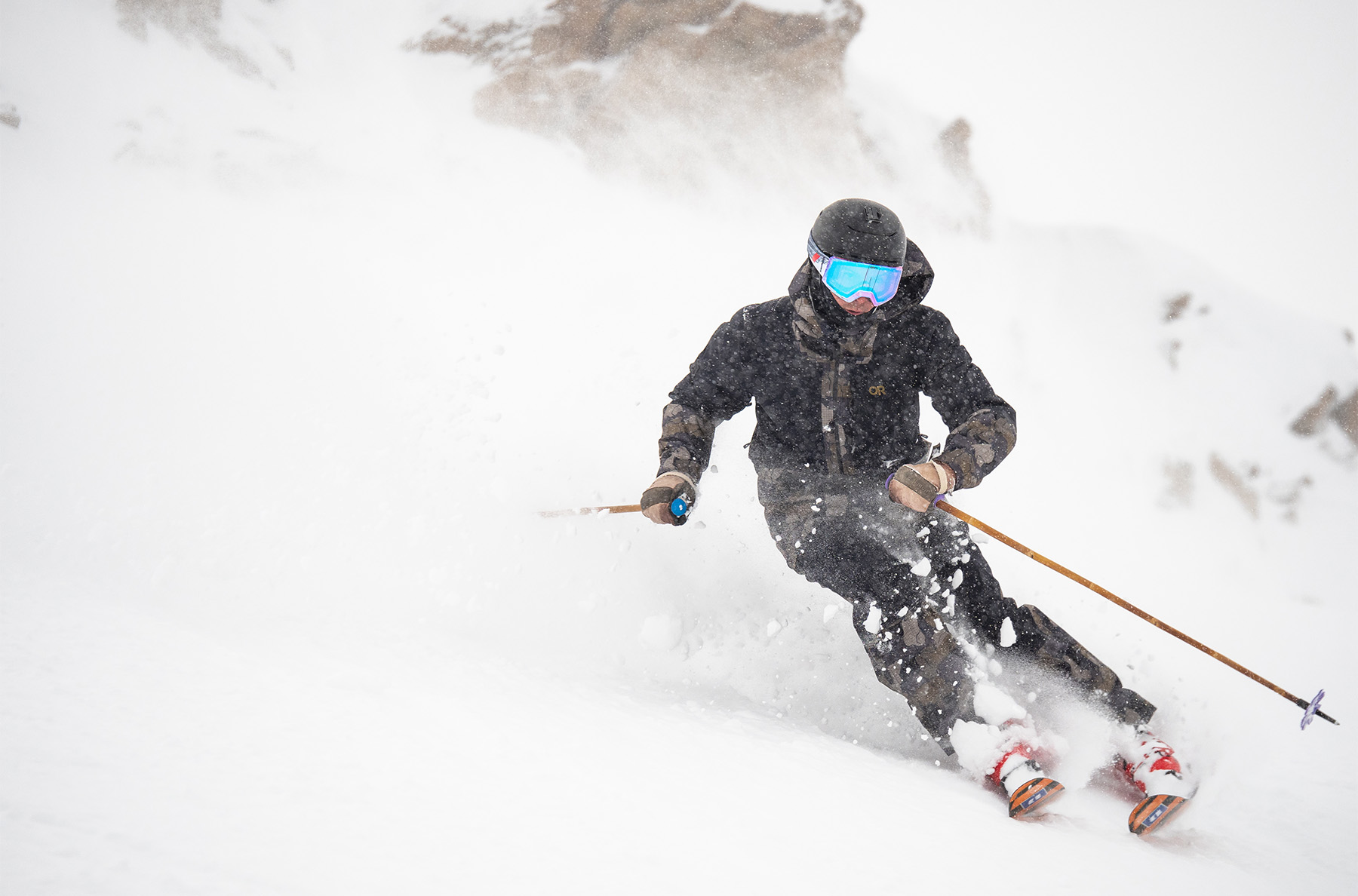
[Editor’s Note: Sam Shaheen wrote the original version of this article, and Luke Koppa contributed to the latest update.]
Intro
What’s the best way to dress for ski touring when it’s sunny and hot? What about ski touring in wet environments? Alpine climbing in mixed conditions? Lift-accessed skiing in the dead of winter?
For a while now, a number of readers have asked us to put together an article on how we think about layering — i.e., how we dress for different activities and different climates.
While that’s a great question, we had put it off because, in the past, there really weren’t too many interesting options and combinations — you had basic baselayers, fleece jackets, puffy jackets, and waterproof shells (most of which were pretty similar). Not so interesting.
But over the past several years, we’ve seen a significant increase in the diversity of what’s available on the market. Shells now operate on a wide spectrum from ultra-weatherproof Gore-Tex Pro to more breathable options like Polartec NeoShell and the increasingly diverse array of brands’ proprietary options; baselayers are no longer a simple choice between wool vs. synthetic; and the options for insulation pieces are now more varied than ever.
So that’s what spurred this Layering 101 article, where we’ll be going through the different types of baselayers, midlayers, and shells, and talking through the most common and notable technologies in each category.
We’ll also offer some brief thoughts on how we go about putting together layering systems for various activities and scenarios. And if you find that part interesting, be sure to keep an eye out for our upcoming “What We’re Wearing” series, where a whole bunch of our reviewers will break down their entire head-to-toe kits for where and how they recreate during the winter.
This article is primarily focused on cold-weather activities, since those typically present the most complex layering requirements, but much of the general information can be applied to just about any climate and activity. And as with all of our Gear 101 articles, this piece’s goal is breadth, not depth. So there are always going to be some exceptions to the generalizations we discuss here, and certain things will be more or less practical for your specific case, depending on a host of factors.
So What’s Changed?
There are many contributing factors to the overall paradigm shift of the apparel industry moving from an ethos of “100% waterproof and super warm,” to a concerted focus on breathability. Chief among those factors is a huge move to human-powered mountain travel. High-output activities like backcountry touring and mountaineering require garments to breathe far more than, say, lift-served skiing.
As a result, we now have air-permeable, waterproof-breathable membranes (e.g., Polartec NeoShell, eVent, The North Face’s Futurelight), even more breathable but not fully “waterproof” softshells, and breathable insulation pieces from most brands.
Along with this shift toward breathability, we are also seeing a shift toward specialization — gear that is designed with a singular activity and specific end user in mind.
So with all that said, let’s first get into the common categories of layers and the most notable types of each.
Baselayers
Baselayers are probably the most personal / subjective part of a layering system. The ideal weight, fit, and fabric of a baselayer can vary widely from person to person. From skintight and paper-thin to relaxed cuts and fleecy materials, there’s a lot to choose from.
Beyond the personal choices of fit and fabric weight, it really comes down to the materials.
There are three primary base layer materials in use today: synthetics, wool, and synthetic / wool blends. We’ve also seen a rise in fabrics made from various wood-pulp-based sources, so we’ve added a section on those pieces, too.
That said, it’s important to keep in mind that a whole bunch of baselayers these days are comprised of blends of different fibers and/or fabrics, so it’s always a good idea to check the fiber content of a given piece to get an idea of what sort of materials are used and how much of the overall fabric each material comprises.
Synthetics
Synthetics (most often polyester or nylon) tend to be cheaper than wool and come in a huge variety of constructions and weights. In terms of general performance, synthetics tend to wick a bit better and dry faster than natural fibers since they’re typically hydrophobic, and they can be more durable than wool (especially compared to really lightweight wool fabrics).
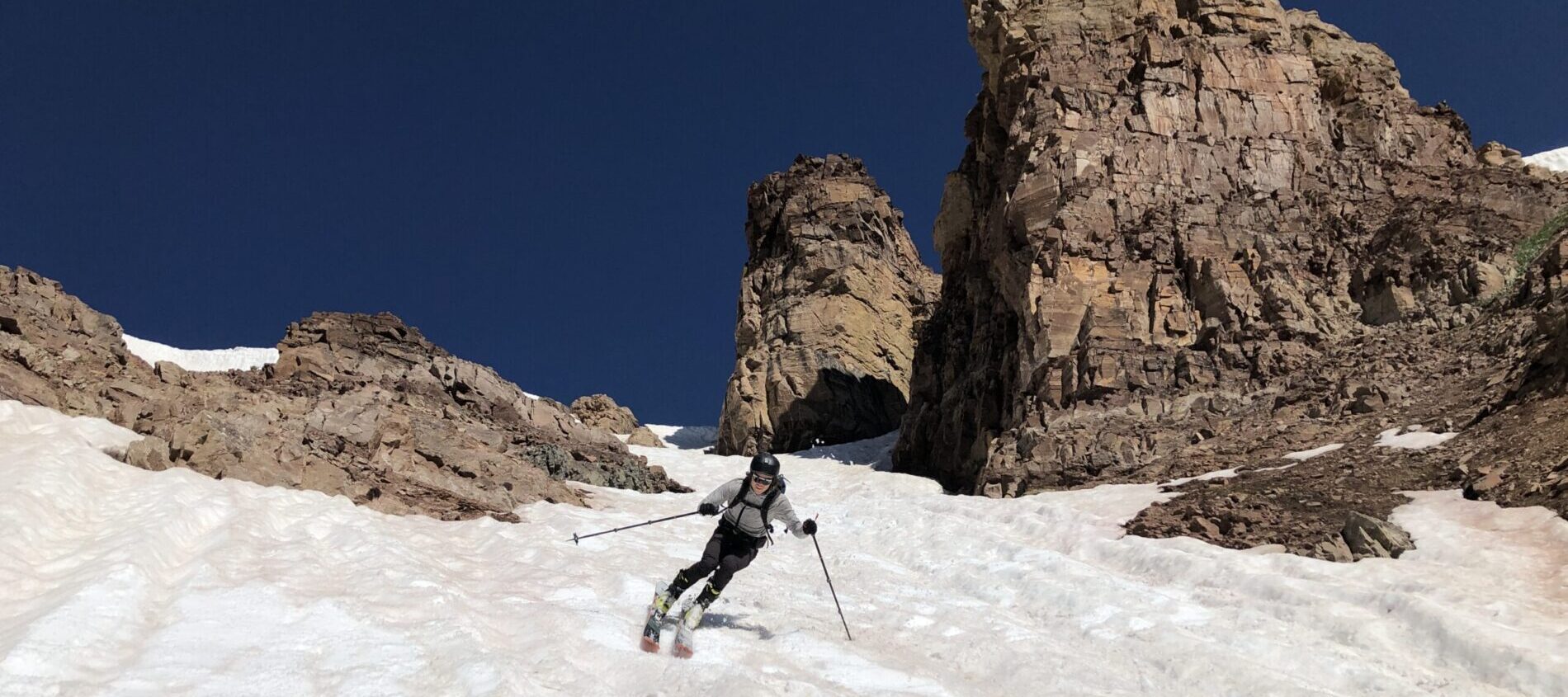
Without treatment though, most synthetics will start to smell terrible after minimal use. As a result, there are many different anti-odor treatments out there, and not all of them are created equal.
Many treatments rely on the antibacterial properties of various silver and copper compounds. This brings about some environmental issues of mining and resource utilization, water usage in treatment application, etc. However, many popular treatments these days are Bluesign-approved and meet rather rigorous environmental and product lifecycle standards. So, if you’re looking at treated base layers, keep an eye out for 3rd-party certifications (which are worth looking into for just about any apparel).
(Just about all apparel these days is treated with some (or several) surface treatment to boost performance; for a deep dive on that, listen to Episode 251 of our GEAR:30 podcast with Beyond Surface Technologies.)
Other noteworthy generalizations about synthetic baselayers include the fact that, typically, fully synthetic pieces aren’t quite as soft as natural fibers. However, “synthetic” fibers and fabrics vary to an extreme degree, due to how customizable they can be, so trying something on (and/or reading our reviews…) is always useful.
Wool
As the main alternative to synthetics for technical baselayers, wool has come a long way in the past few years — it’s no longer always scratchy like the ski sweaters of old. High-quality wool can be soft, supple, and itch-free. It is also naturally odor resistant, which is a huge plus for high-output activities, and for those of us who just don’t want to have to wash a piece after every day we use it. On top of that, wool tends to breathe quite well while simultaneously doing a good job of insulating when used under other layers.
Wool, however, can be expensive, often doesn’t stretch or maintain its shape quite as well as synthetics, isn’t quite as durable, and generally doesn’t dry as quickly as synthetics.
Wool baselayers come in a variety of weights and knit constructions, and companies differ when it comes to categorizing them, but you’ll most often see a fabric weight provided in grams per square meter (g/m2 or g/sm). These weights range from about 100 g/sm at lightest end, and extend to up to around 300 g/sm for heavy, winter-weight base layers.
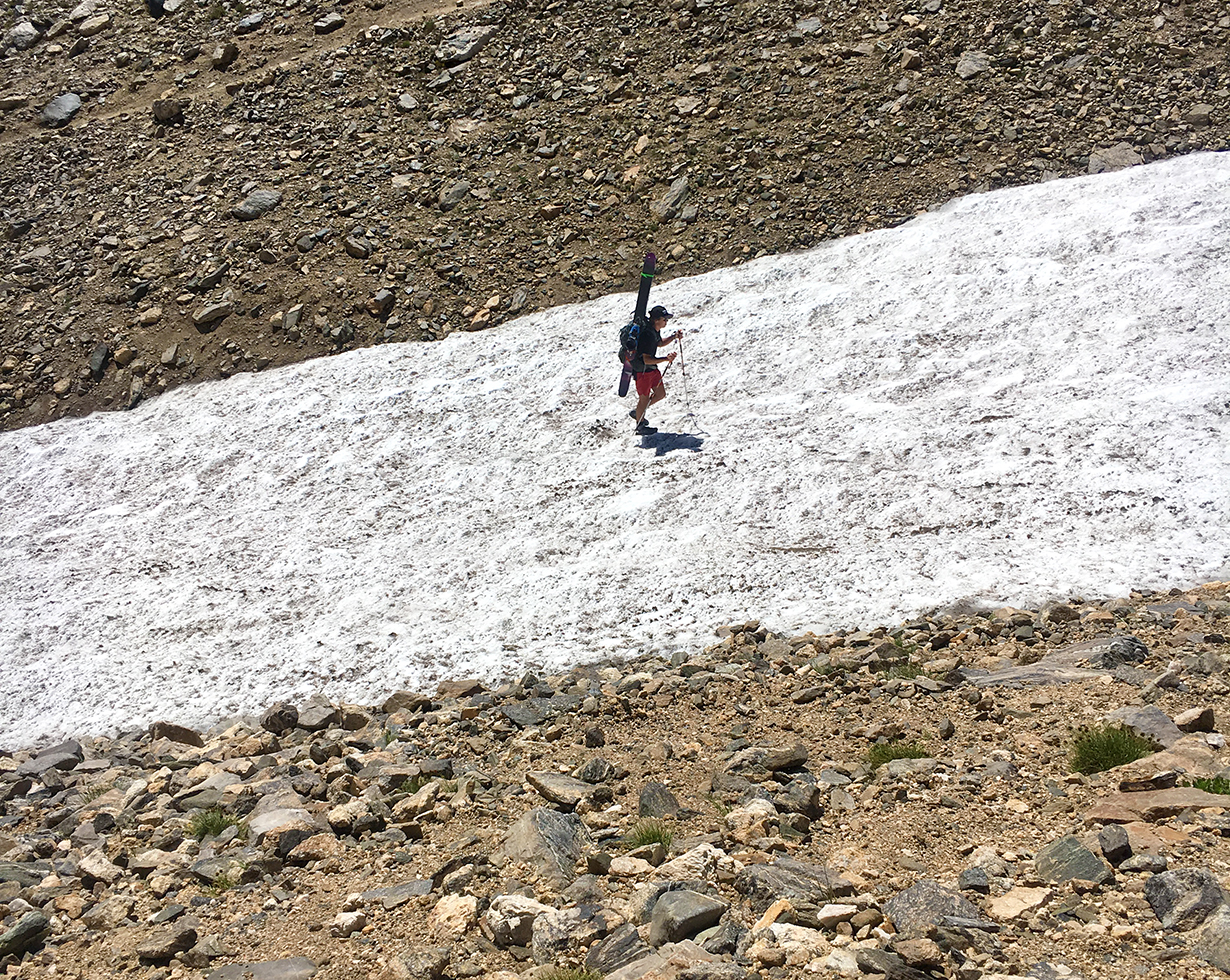
One tricky thing about wool: it’s tough to judge the quality of wool without actually feeling it, but the wool fiber’s diameter (when provided) can usually be a good number to reference. Pretty much all “merino wool” is smaller than 24 microns in diameter (human hair is ~50 microns), and the finer the wool, the more comfortable it often is. Most of the brands producing high-end merino baselayers use wool with an average diameter of around 18 microns, with more expensive products using even finer wool.
Of course, sheep aren’t the only things that produce wool. While not nearly as common, you can find technical baselayers made from wool / fibers that come from yaks, alpacas, llamas, goats (e.g., mohair), bison, and more. These maintain similar performance properties to merino wool but all offer their own, slightly different characteristics that we won’t go into right now, given their relative scarcity.
Wool / Synthetic Blends
In reality, 100% wool baselayers are actually fairly rare these days, with wool / synthetic blends becoming popular because of how they can mitigate some of the downsides of each category while maximizing some of their upsides. These blended baselayers tend to be around the same price as pure-wool layers and offer (most of) the breathability and odor resistance of wool as well as (most of) the stretch, moisture wicking, shape retention, and durability of synthetics.
Many of these blends use “core-spun” yarns, which essentially consist of a long synthetic fiber that’s wrapped in wool fibers. This makes the fiber more durable thanks to the synthetic core, but maintains most of wool’s performance characteristics.
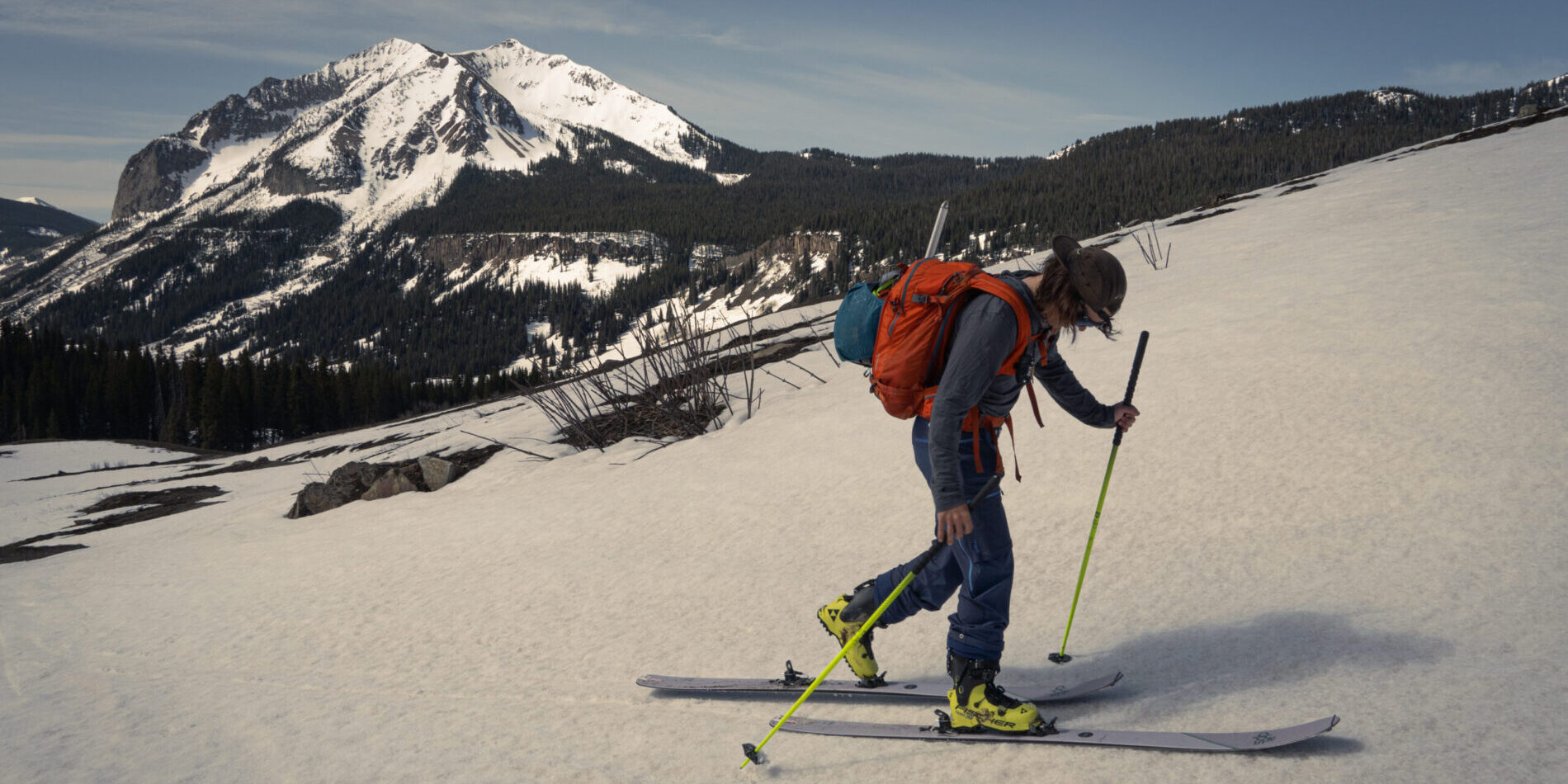
One of the more exciting developments we’ve seen in wool / synthetic blends is NuYarn, which is a proprietary method of combining merino wool and synthetic fibers. The construction method details are still a little fuzzy (since they’re proprietary), but in our experience, NuYarn fabrics are considerably stretchier, more durable, slightly better wicking, and slightly warmer than most core-spun blends.
One thing to keep in mind is the ratio of the materials used in a given fabric. E.g., a fabric with more than 50% wool fibers will often perform pretty similarly to pure wool in many regards, whereas one that’s only 20% wool might not feel or perform very differently from a pure synthetic fabric. While most of the mainstream brands are upfront about the content of their apparel, it’s not totally uncommon for brands to overstate, exaggerate, or overemphasize the content of a particular fiber if it might make a given piece seem more valuable. E.g., calling something a “wool sweater” when it’s actually 80% cotton and 20% wool seems like a stretch.
Other Non-Cotton Natural Fibers (e.g., Rayon from Bamboo, TENCEL, TENCEL Modal, Lyocell)
Over the past few years, we’ve seen more and more brands releasing layers that use “natural” fibers that aren’t cotton or wool. For the most part, these tend to be made by turning some type of wood or grass (commonly bamboo or eucalyptus) into a pulp, then further processing it into fine cellulose fibers, twisting that into yarns, and weaving or knitting those yarns into fabric.
Ironically, these “new” fibers are quite similar in concept to “rayon” or “viscose” fibers that have been around for decades, though the specific wood sources, refining processes, solvents used, amount of water necessary in production, and other factors have changed over the years and vary among the numerous “wood-pulp-based cellulosic” fibers out there. “Greenwashing” seems pretty common in this category, but as with any fabric, a given brand’s transparency and 3rd-party certifications regarding material sourcing and production processes will help you figure out just how “green” a given fabric is.
In terms of performance, these cellulose-based materials tend to be quite soft, breathe a bit better than cotton, resist odor buildup a bit better than synthetics, and don’t tend to be quite as expensive as pure wool. They don’t wick or dry as well as most synthetics, and aren’t typically as warm or odor resistant as wool. We typically see them combined with wool and/or synthetic fibers for the same reasons wool / synthetic blends exist; the addition of a material like TENCEL usually serves the purpose of making the overall blend softer and more comfortable.
Increase Baselayer Versatility by Decreasing Complexity
Whatever material you decide to go with for a baselayer, the most important things to consider are the fit and weight. As we stated earlier, this largely comes down to personal preference, but there is a lot to be said for simple, slimmer-fitting, and thin baselayers (Luke and my personal preferences). My main rationale:
- Slim fits layer easier under other garments and tend to retain heat better than loose-fitting garments.
- Thin baselayers are more versatile because they can be used in a wider range of climates and activities — you can just combine them with warmer midlayers for colder conditions, or vice versa. Generally, different midlayers are going to offer a far broader range of performance traits than baselayers, given how simple baselayers are in comparison.
- Simple cuts (like short-sleeve crew-neck baselayers) further increase versatility by reducing unnecessary zippers and fabric that can be annoying when combined with other layers. Plus, many “technical” baselayers with these simple cuts can do double-duty as casual, everyday pieces.
There are a lot of options out there for baselayers, and many of them are pretty good. If you want an idea of some of our favorite options and what differentiates them, check out our Base Layer Index, our monthly “Stuff We Like” series, and our various apparel reviews.
Insulation & Midlayers
Every piece of a layering system contributes to its performance traits, but typically, midlayers are where you get most of your insulation and warmth. However, there are also lots of “insulation” pieces that are designed to be worn as an outer layer, not in the middle. I.e., pretty much all midlayers are insulation pieces, but not all insulation pieces are midlayers. And as with the other parts of a layering system, insulation pieces vary a lot, with a few general categories.
Fleece
The first insulation style we’re going to discuss is fleece. The fleece midlayer has certainly evolved a bit since the Polartec Polar Fleece circa 1979, but modern fleece fabrics operate on the same, nearly 40-year-old principles. Compared to other midlayers, Fleece options tend to be breathable, quick-drying, and with moderate warmth-to-weight ratios. Most commonly, they’re made from synthetic fibers.
Modern fleeces are usually lighter, more packable, and more comfortable than they were in the 80’s. But more than that, the real innovation in fleece has been the development of a huge number and variety of knits and weights, allowing you to pick a highly specialized garment that will perform exactly how you need.
From the extremely breathable, low-density knit of Polartec Alpha Direct to much more substantial “hardface” fleeces (fabrics with a higher-density, tighter knit on the face and a lower-density loft on the inside) that block some wind and precipitation, picking a fleece is mostly about understanding what you’d like to use it for and understanding how it fits into your larger layering scheme.
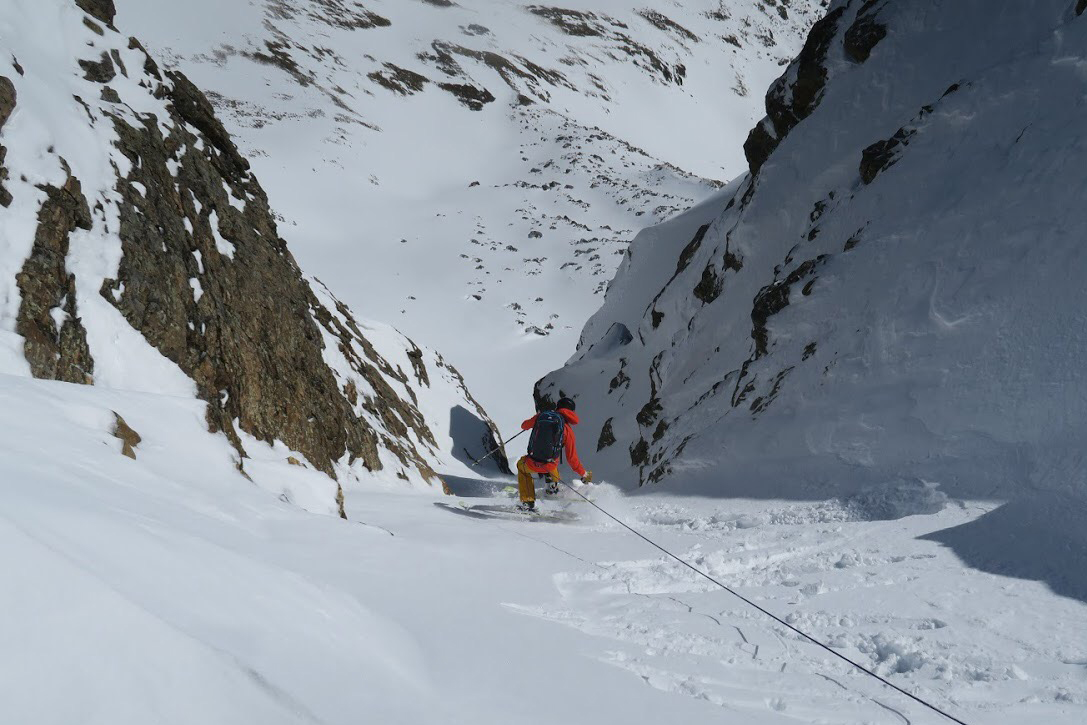
For example, I spend most of my time in the mountains ski touring and alpine climbing, two fairly high-exertion activities. Because of this, shells and puffy insulation often stay in my pack, while more breathable layers like fleece and active insulation pieces stay on for most of the day.
I usually prefer a thinner fleece with a harder face because it can be used as an outer layer in mild weather conditions and the harder face tends to layer (i.e., slide / not snag) better under other garments. Super breathable, low-density, open-knit fleeces like Polartec Alpha Direct block almost zero wind and can be a bit grabby under / over other layers, though they’re typically much lighter, more packable, and offer much better warmth-to-weight ratios than more dense, harder-faced fleeces.
Fit is also quite important for fleece. In general, the higher output your activity, the more you’d benefit from a slimmer fit. I like a fleece that fits well over a slim base layer and is slim enough itself to fit under any other midlayer or outer layer I may need, but with a well-patterned cut that doesn’t impede range of motion.
Fleeces, baselayers, and shells are the layers I rarely change based on conditions. In colder or warmer conditions, I’ll choose an appropriate puffy insulator(s), but I like to keep the baselayer, fleece, and shell fairly consistent for simplicity, and because there often isn’t that much to be gained by fiddling with every part of your kit each time you go out, unless you very often deal with extremely different conditions on a day-to-day basis.
Active Insulation
This segment of the market has seen huge changes in the past several years, and there are now some really cool products available. In general, when I say “active insulation,” I’m referring to batted or knit insulations that breathe significantly better than traditional lofted insulation (e.g. down, synthetics like Primaloft, etc.) and that are combined with softer, more breathable shell and lining fabrics. Active insulation pieces tend to be a bit warmer, more packable, more protective, and more expensive than fleece while still maintaining enough breathability to be kept on for moderate-output activity. Compared to traditional puffies, active insulation pieces generally aren’t as light, warm for their weight, packable, or weather resistant, but are typically more breathable and comfortable.
While still relatively new, most brands now offer at least a few midlayers that fall under the active insulation category.
I find active insulation to be best suited for medium- to low-output activities like resort skiing and alpine climbing because these pieces work well for the stop-and-go nature of these sports. When paired with a shell, active insulation can work across many conditions and temperature ranges — much more so than traditional puffy insulation.
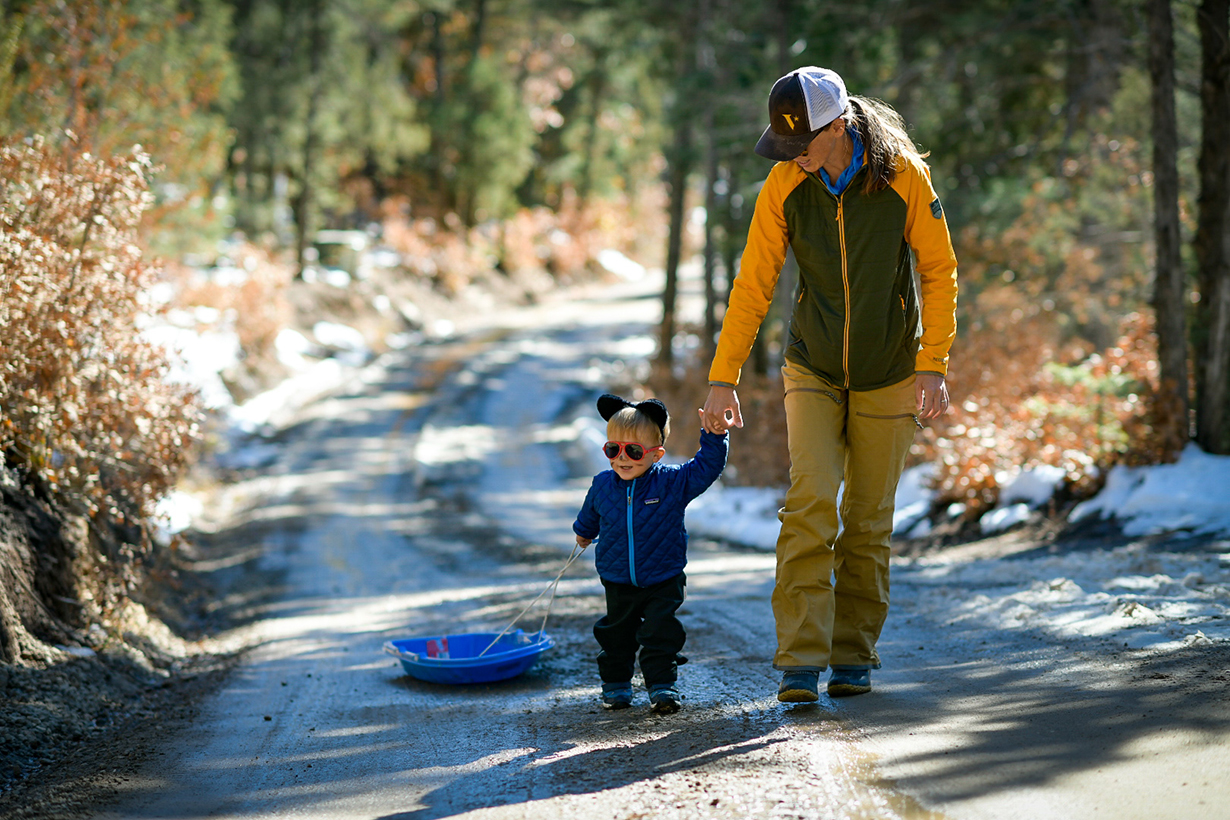
However, for high-output activities, I often find them to be a bit warm. Plus, when the weather gets bad, I almost always throw a shell on over my midlayer. If that midlayer is a midweight active insulation piece, I tend to get too warm with the shell. However, if my midlayer is a thinner fleece, I don’t often overheat in the shell during bad weather. That said, now that this category is more established and popular, the variety of active insulation pieces has increased, with lighter, more minimally insulated options that bridge the gap between light fleeces and more standard active insulation midlayers.
Same as traditional synthetic puffy insulators, most active insulations are classified by the insulation’s weight (e.g., 60 grams per square meter, or 60-g/sm, or 60-g/m2, or simply 60-g). 60-g is what we’d typically consider “standard” or “average” for a midlayer, offering enough warmth under a shell to feel comfortable in most winter scenarios, but often being a bit too warm for high-output activities. Many companies offer active insulators with a hybrid construction; e.g., no insulation or lighter insulation under the arms, and heavier insulation around the core. While many active insulators are constructed similarly to traditional synthetic puffies (lining fabric, shell fabric, and a batted insulation sandwiched between), the main differences come down to the types of fabrics and insulations, which are optimized more for breathability and stretch, rather than warmth-to-weight ratio and weather resistance.
Puffy Insulation (Down & Synthetic)
This old standard still very much has a place in modern layering schemes. Nothing else can match the warmth-to-weight ratio of high-fill-power down or top-of-the-line synthetic insulations. Sure, they don’t really breathe and they can be very expensive, but a good puffy jacket is about the only piece of gear that can fit into just about every person’s layering scheme — regardless of activity.
Puffy insulation fits into two main categories — down and synthetic. The tradeoffs are fairly straightforward. High-fill-power down has a better warmth-to-weight ratio but loses loft (and warmth) when wet and is very expensive. Synthetic options retain more warmth when wet and tend to be cheaper, but are typically heavier. The most impressive synthetic insulations we’ve used in terms of nearing down’s warmth-to-weight ratio are Patagonia’s PlumaFil and Outdoor Research’s VerticalX SuperStrand; they’re still quite not as good in that regard as 800+ fill-power down, but they’re not wildly far off.
An aside on fill-power and warmth: the fill-power numbers of down insulation are quite confusing and often marketed incorrectly.
The fill-power of down does not equate to the overall warmth of a garment. Or more accurately, it’s only a piece of the puzzle / equation.
An 800-fill-power jacket can easily be (and often is) less warm than a 500-fill-power jacket. For example, a Canada Goose Langford Parka uses 625 fill-power down and is FAR warmer than the Mountain Hardwear Ghost Whisperer jacket, which uses 800-fill-power down.
Fill power is a measure of how much volume one ounce of down will occupy, measured in cubic inches per ounce. Higher fill power means a better loft-to-weight ratio — which translates into a better warmth-to-weight ratio. However, the amount of down in the garment (aka, “fill weight”) is often more of a factor in terms of ultimate warmth; unfortunately, most companies do not provide that info. If you need great packability and the best possible warmth-to-weight ratio, then high-fill-power down is worth a look, otherwise, you could save some money and go with lower-fill-power or synthetics options.
Choosing a puffy insulator depends on where you’ll be recreating and the activities you expect to use it for.
Synthetic insulations make a lot of sense for wetter climates, while in drier climates, down can be a better alternative. Just remember that a down jacket that’s been saturated with water or sweat is basically worthless. Even water-resistant “dry down” treatments only delay the inevitable in sustained wet conditions. On the other hand, down garments can often be more durable in the long run (when taken care of properly), and they’re still hard to beat in terms of packability / weight.
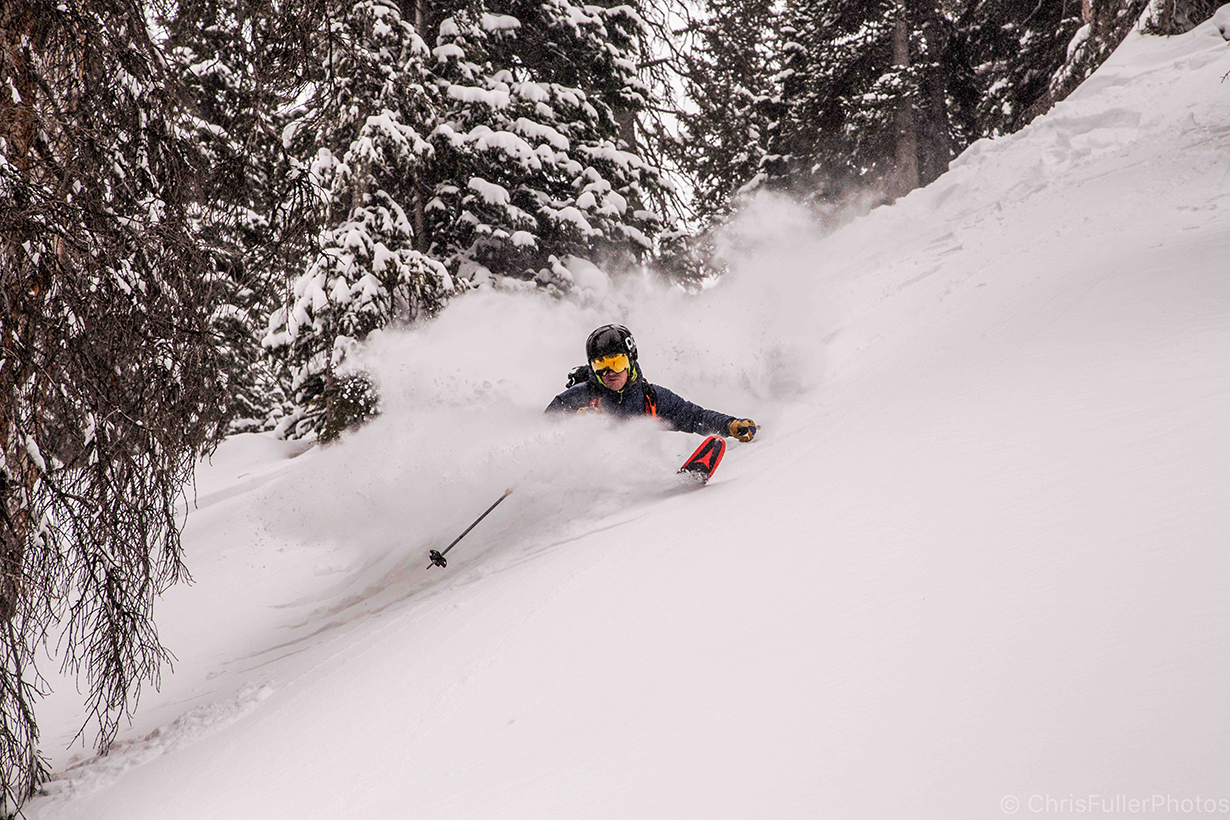
Choosing the appropriate weight is also important. Because they don’t breathe much at all — and as a result are typically worn when you’re sedentary — I like to err on the warmer side of the spectrum when it comes to puffy insulation. To this end, I also prefer a slimmer fit that retains warmth better than looser cuts (apart from big belay-like jackets that will be tossed on over all my other layers).
In general, average synthetic midlayers use 60-g/sm insulation, and then 100 and 120+ g/sm synthetic insulations are usually used for heftier belay and parka-styled garments. Down fill weight is unfortunately not often made available, which makes it extra difficult to try and judge a garment’s warmth based simply on specs. Across the board, though, the general rule is: the puffier / more voluminous the insulator, the warmer it’ll be.
For many of us, traditional puffy insulators are what we use for more sedentary activities like frigid lift-accessed riding, belaying a climbing partner in the alpine, or simply walking around town during the colder months. They’re also really useful to keep in your pack for the transition periods of high-output activities (e.g., switching from uphill skinning to downhill skiing while touring), and as “just in case” layers in the event that you end up stuck in the cold for longer than you anticipated. It’s rare that I or any of our reviewers will go skiing touring or climbing in the winter without one stashed in our pack.
Outer Layers
(For reference, you can learn more about shells and outerwear in general in our Outerwear 101 and 201 articles)
Softshells
Softshells are probably the most variable layers here. Everything from lofty hard-faced fleeces to thin 3-layer laminates with waterproof-breathable membranes can live under the “softshell” umbrella. When we first started seeing the term “softshell” appearing in the marketing copy from outdoor apparel brands, it typically referred to pieces that weren’t fully waterproof, were more breathable than traditional “hardshells,” featured thicker, heavier fabrics, and that were … softer. Those generalizations still hold up in most cases but are not nearly as universal as they once were.
High-loft fleeces with harder, densely knitted faces make up the less technical side of the softshell spectrum, and seem to have decreased in popularity over the years. These shells offer good warmth and decent weather protection, potentially functioning as both a midlayer and outer layer, but are heavy, aren’t very packable, and don’t tend to breathe all that well relative to more traditional fleeces.
More recently, we’ve seen a rise in simple, single-layer, “stretch-woven” softshells. These often resemble “wind jackets” with a thin fabric that’s treated with a water-repellant coating that’s capable of blocking some wind and light precipitation; however, the “softshell” versions are typically much stretchier and more breathable. The term “stretch-woven” typically just refers to a fabric that is woven (rather than knit, like fleece would be) using at least some fibers like elastane that offer stretch characteristics. These pieces are often really packable and more versatile than the wind shirts of old because of their improved breathability and stretch, but don’t offer much inherent warmth and aren’t as protective against wind and water, relative to 3-layer hardshells and softshells.
On the more protective and complex side of the softshell spectrum are thin 3-layer (i.e., “3L”) softshells with membranes. These garments are often difficult to distinguish from hardshells since they are both constructed very similarly with a face fabric, membrane, and backer fabric. However, the softshell versions tend to be softer (go figure), more breathable, and less water resistant than hardshells. A notable example of this class is Polartec Powershield Pro, which features a 3L construction like a hardshell, but is notably more supple, considerably more breathable, heavier, and doesn’t have a water-resistance rating high enough to be considered “waterproof” by most folks’ standards.
There are several other options within this spectrum, many of them without membranes and with harder faces while still being very stretchy and durable with a soft hand-feel. Regardless of where in the spectrum a softshell falls, comfort and breathability are the things that typically set them apart from their hardshell counterparts.
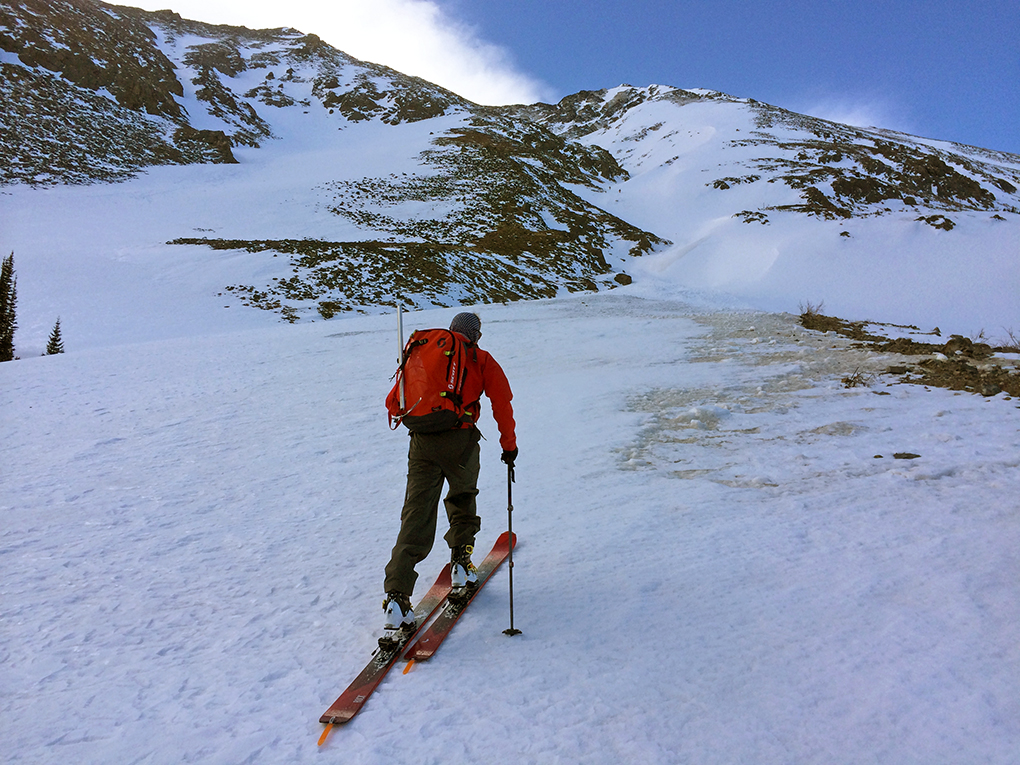
Personally, I love softshells — specifically thin 3L softshells with a membrane. I think they are grossly under appreciated, especially when it comes to ski touring and mountaineering. Softshells are more breathable, more comfortable, and typically cheaper than hardshells, and they tend to offer plenty of weather protection for many days in the mountains — most days don’t require the protection of a hardshell, so why do we always wear one?
Most of my favorite pieces that fell under this category have since been discontinued (R.I.P. to the Patagonia Knifeblade…). However, what we are now seeing is an ongoing blurring of the lines between “softshells” and “hardshells,” with some new 3L shells forgoing some level of weather resistance in exchange for much better breathability. E.g., Strafe’s latest Cham kit uses a 3L fabric from Schoeller, dubbed “Aerobrane,” that more closely resembles hardshells in terms of construction, but that rivals the Knifeblade’s Polartec Powershield Pro fabric in terms of breathability and comfort, while being far lighter and potentially more water resistant. So, as always, it’s best to do some research, keep an eye out for ratings / certifications, and (whenever possible) check out stuff in person.
Hardshells
Hardshells offer the most weather protection of all of the layering pieces discussed here. During the wettest, windiest, and/or coldest times, reach for a hardshell. Otherwise, a hardshell is often overkill, especially hardshell jackets. I’m more often wearing a hardshell pant than jacket since pants tend to get abused a bit more than jackets and most people don’t tend to create quite as much heat in their lower body.
Hardshells have been dominated by Gore-Tex membranes and fabrics for the past several decades. And Gore does make great hardshell fabrics, but there are many other viable options today. Third-party membranes like eVent, Polartec NeoShell, Toray’s Dermizax, and Schoeller Aerobrane are excellent choices, and many companies use their own proprietary membranes that also just as well (if not better) than the bigger brand-name alternatives. The main benefit that Gore-Tex brings to the table is reliability with their “guaranteed to keep you dry” promise. Check out our Outerwear 101 article if all this talk about membranes sounds a bit confusing.
Regardless of brand, the typical tradeoffs with hardshells endure: comfort and breathability are decreased in favor of increased durability and weather protection.
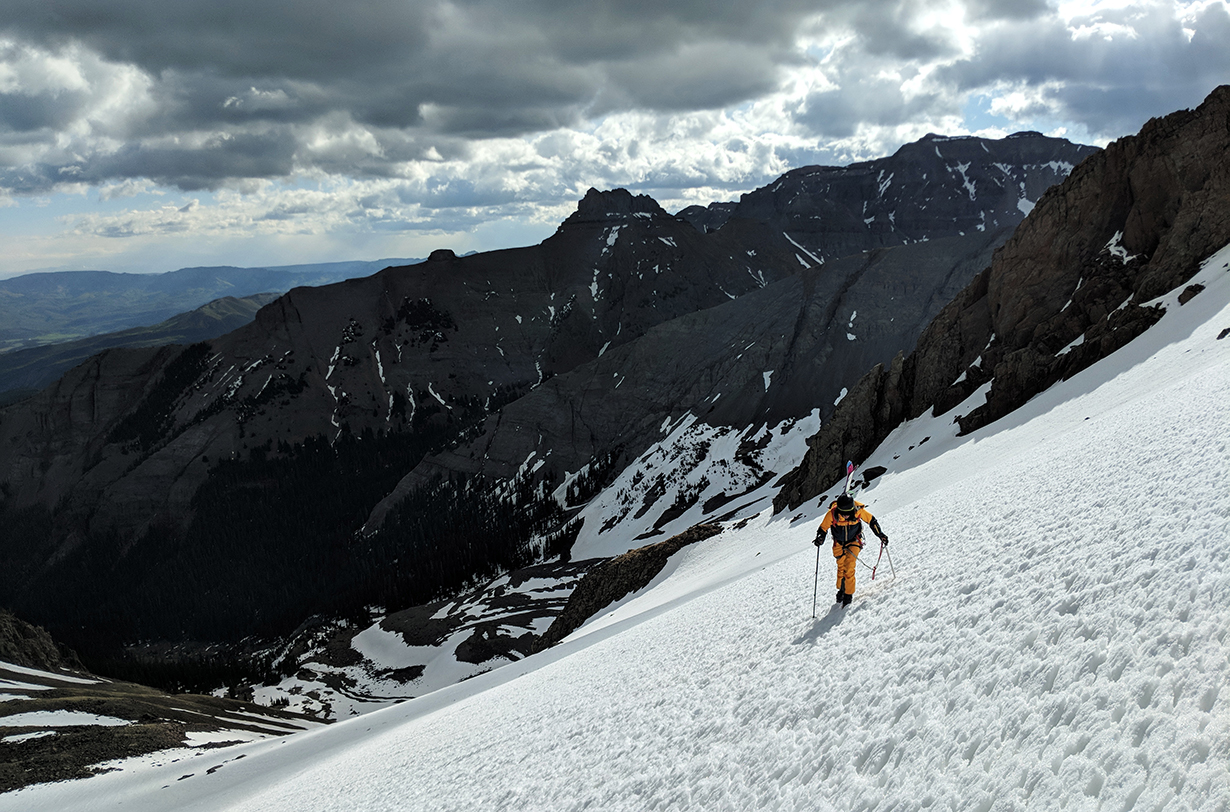
In general, as with every layer we’ve discussed, the important thing is identifying your end use. Hardshells are expensive and therefore I recommend looking into versatile 3- and 4-season options that will work for a variety of activities. Take into account what pocket layout, features, and fabric weight you need for most of your year-round activities. There’s a wide variety of options, from ultralight to super burly, extremely protective to fairly breathable, and so on.
One of the main trends we’ve noticed over the past several years is the shift toward using more supple, stretchy, and comfortable face and backer fabrics for “hardshells.” Traditional hardshells are pretty crinkly, stiff, loud, and not very comfortable, but now there are lots of 3L hardshells that buck that trend.
Another big trend is the rise of air-permeable membranes, which tend to offer better breathability and comfort during high-output activities than non-air-permeable membranes. That said…
An aside on water resistance and breathability ratings and standards:
This is a topic we’ve discussed extensively and we’ll try to avoid going all the way into the weeds here, but rather, note the highlights. In short, the water resistance and breathability ratings that companies often provide for their hardshells (and sometimes, softshells) are useful baselines, but by no means perfectly reflect real-world performance.
You’ll often see a shell fabric listed as having a “20k/20k” waterproof / breathability rating. You can find more info on what that actually means in our Outerwear 101 and Outerwear 201 articles, but as a general rule, a fabric with a water resistance rating of 10k (aka, 10,000 mm) or higher is often considered “waterproof”; the higher its breathability rating, the better it will move moisture from the inside to the outside when you work up a sweat. However, even a Gore-Tex Pro fabric, which is generally rated around 28k for water resistance, can allow water to pass through the membrane in certain scenarios (particularly when subjected to abrasion / pressure, like kneeling in the snow or wet ground). Similarly, breathability ratings do not tell the full story of what you’ll experience, since the most common rating / standard is about moisture vapor transfer, not simply air transfer. Most non-air-permeable waterproof membranes only “breathe” and allow moisture to transfer once the humidity of the interior (by your body) exceeds that of the outside environment. And more importantly, the fact is that no water-resistant or “waterproof” shell with a membrane breathes very well in the grand scheme of things. So while high-end hardshells and some softshells are referred to as “waterproof and breathable,” how well they live up to that description can vary a lot and should be taken with a grain of salt. A small number of brands offer CFM numbers (cubic feet [of air] per minute) for their air-permeable fabrics, and in our experience, that’s more useful when figuring out how “breathable” a shell will feel in reality.
This lack of usefulness for certain apparel ratings and standards is the main focus of one of our Blister Labs projects with Western Colorado University, where we’re working to create and implement more useful testing standards. You can find all of the latest updates on Blister Labs here.
Sub-Category: Insulated Outerwear / Insulated Shells
Not all water-resistant outer layers are super thin; most companies also make products that essentially combine “insulators” and “shells” into a single piece, making for a garment that’s warmer than uninsulated shells but more protective against water and wind than most traditional insulators. In general, the upsides with insulated shells are typically value and simplicity. Insulated shells often feature less-expensive 2-layer waterproof fabrics than their uninsulated brethren and almost always cost less than buying an equivalent separate midlayer and separate uninsulated shell. The primary downside with insulated shells is decreased versatility — you can’t separate the insulation from the shell, which makes them less adaptable across different temperatures and scenarios.
Insulated shells are often a combination of traditional puffy insulation (i.e., synthetic or down) and a fully waterproof hardshell fabric, so they’re generally best suited to colder weather and lower-exertion activities, such as mid-winter lift-accessed skiing / riding. They’re not your best choice if you’re trying to build a super versatile, do-everything layering system, but they can be a great way to save some money on, say, your resort skiing kit. Some people also just prefer the simplicity (and in some cases, increased comfort due to fewer layers) of a single piece that fulfills the role of both insulator and shell. If you fall into that camp, the good news is that insulated shells have been getting slightly more versatile over the years, with the influx of active insulations, air-permeable waterproof laminates, better ventilation, etc.
Layering Combinations Based on Activity — Some Examples
Let’s look now at some potential layering combinations, while keeping in mind that there are a huge number of efficient ways to layer. I.e., these layering examples are just that — examples. Your ideal layering combos are going to depend on context, like what activity you’re doing, where you’re doing it, your specific physiology, etc.
The best layering scheme is the one that you are familiar with. Get to know the gear you have, then go from there. The best thing you can do is to inventory your current closet and understand what each piece does and how it works with your other layers. How warm, light, breathable, or protective is it? Where does it excel? Where does it fall short? Only then, if you have glaring gaps, should you look into getting something brand new (as you’ll see, many of my go-to pieces aren’t new and have actually been discontinued for years, but I still prefer them).
While the examples below are highly specialized, most people aren’t using totally different layering setups for all the different things they do outside; again, versatility is always important to consider.
Ski Touring / Ski Mountaineering
Ski touring is how I spend the majority of my days in the mountains, and I therefore spend a lot of time in this layering scheme and have found that it works well for me. For reference, my layering examples mostly reflect the terrain in which I spend the most time, the Colorado Rockies. That means I’m not typically encountering a ton of really wet precipitation during the winter and temperatures are usually pretty cold / rarely getting above freezing mid-winter, though, depending on the sun and wind, there can be huge temperature swings over just a few hours.
When ski touring, I’ll typically start the day in a baselayer, fleece, and shell — quickly ditching the shell as I warm up. Once at the top of the line, I’ll throw on a puffy insulator over the fleece (or shell if I’ve put that on to block wind) to stay warm during the transition. Before skiing, I’ll often stow the puffy and put the shell on. Then, ski, rinse, and repeat until my legs are noodles.
Main Focus: Breathability
- Baselayer: Lightweight (100-200 g/sm) wool crew neck (short or long sleeve)
- Fleece: Midweight, hardish-face fleece with hood, slim fitting (e.g., Patagonia R1 TechFace)
- Insulator: Synthetic or down puffy jacket (e.g., Patagonia Micro Puff Hoody, Montbell Alpine Light Down Parka, Rab Zero G)
- Jacket Shell: Thin, minimal softshell (e.g., Patagonia Knifeblade Jacket)
- Pants: Thin, minimal softshell or hardshell with good vents (e.g., Patagonia Knifeblade Pants, The North Face Summit Series L5 Pants)
[Luke Koppa: I approach my ski touring layers very similarly to Sam. That said, I think I run a bit hotter than Sam, and consequently, I’ll often skin in just my lightweight wool-blend baselayer. It sucks for a few minutes but as a reward, I don’t get nearly as sweaty (and then cold once I stop) as I would if I started with a midlayer or shell. If it’s quite cold, windy, and/or snowy, then I’ll typically throw a minimal, stretch-woven softshell over that baselayer (e.g., Strafe Recon). If I know there isn’t much or any precipitation in the forecast, I’ll also often leave my shell jacket at home and just ski down in my puffy insulator. For this reason, and for the added peace of mind when it’s stuffed at the bottom of my often-snow-filled pack, I typically prefer synthetic puffies with great warmth-to-weight ratios, such as the Patagonia DAS and Micro Puff series.]
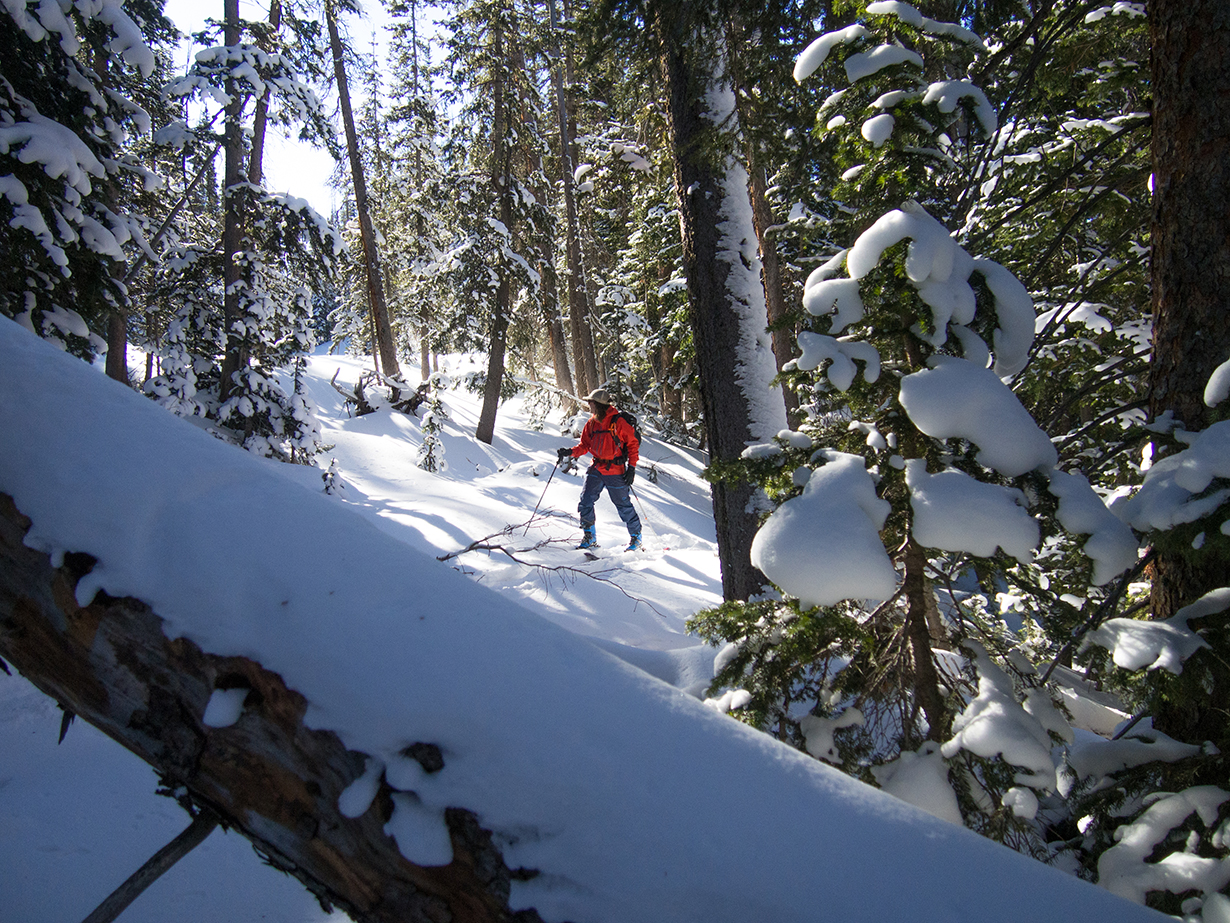
Inbounds Skiing
Inbounds skiing is a fairly easy activity to layer for because it’s relatively sedentary, you’re never too far from the lodge, and weight is not a big issue. I love high-tech and cutting-edge outerwear, but I still often reach for price-point 2L pieces when skiing inbounds. Fancy Gore Pro shells and lightweight insulators are just overkill for most days in the resort.
When skiing inbounds, I keep the same layering scheme all day — mostly because I hate carrying a pack. That means that I dress for the cold parts of the day but plan to vent some heat when the skiing gets hard or if there’s a bootpack.
Main Focus: Durability, Style
- Baselayer: Wool/synthetic light to midweight, fit for comfort
- Fleece: Midweight and inexpensive (100- or 200-weight fleece is perfect)
- Insulator: Active insulation piece — used only on cold days (e.g., The North Face Ventrix, Outdoor Research Ascendant, Patagonia Nano-Air)
- Jacket Shell: 2L or heavy 3L shell with powder skirt — something that will hold up to trees and rocks
- Pants: 2L or heavy 3L with large leg vents — something that will hold up to trees and rocks
[Luke Koppa: Again, Sam and I are mostly in agreement here. Since I run hot, I’m typically fine with a light wool-blend baselayer, midweight (~60-g) active insulation piece like the standard Patagonia Nano-Air, and a shell. This is for most winter lift-accessed days in Colorado. Come springtime, I’ll ditch the midlayer and often the shell, while I’ll occasionally bump up to a heavier midlayer for the truly frigid mid-winter days. Despite lift-accessed riding not being all that intense in terms of body heat output, I’m still a massive proponent of using active insulation as a midlayer; in my experience, they’re comfortable in a far broader range of temperatures than traditional puffies, but can still offer similar levels of warmth when layered under a shell. Once temps creep closer to freezing or warmer, I’ll often swap the active insulator for a light fleece.]
Alpine Climbing / Mountaineering
Layering for mountaineering and alpine climbing is definitely dependent on your objective. So you can take a look at my list, but realize that yours will likely be a little different. For instance, due to the combination of the cold weather and frequent work/rest cycles of climbing in Colorado, I will often bring two insulators, but in many warmer climates, this won’t be necessary.
Main Focus: Lightweight, Safety (warm + dry in emergency situations)
- Baselayer: Lightweight wool crew neck, slim fit
- Fleece: Soft to hard-faced and slim fit, depending on weather (e.g., Rab Alpha Flash Jacket or Patagonia R1 TechFace)
- Active insulator: Slim fitting and light (e.g., The North Face Ventrix, Outdoor Research Ascendant, Patagonia Nano-Air)
- Puffy insulator: Light, slim, and warm (Patagonia Micro Puff Hoody, Montbell Alpine Light Down Parka, Rab Zero G Jacket)
- Shell for Summer: Ultralight hardshell or a softshell that replaces an insulator (Patagonia Storm Racer / Rab Kinetic Plus or Mammut Eisfeld / Patagonia Levitation)
- Shell for Winter: 3L softshell (Patagonia Knifeblade) or hardshell depending on conditions
General, All-Purpose Layers
Here is a list of the basic pieces that I think every person could find useful, and what I think you should focus on for each piece. This list can build a super versatile kit that can be used across most winter conditions that you’ll come up against. (Note: this list is made with skiing in mind as the primary activity, but is generally applicable to many other activities in the mountain.)
- Base layer (Focus: Fit) — The specifics of your base layer aren’t that important, just make sure it fits your body and your budget. As we noted above, going lighter on your baselayers tends to be more versatile, since you’ll get most of your warmth from your other layers.
- Fleece (Focus: Breathability) — Focusing on breathability here will give you the most versatile piece. I like the Patagonia R1 for that use case.
- Active insulation (Focus: Warmth, Breathability) — Find an active insulator that is the right warmth for your activity. The TNF Ventrix and Patagonia Nano Air variants are my favorites. This is probably the least necessary part of this list, since a fleece and/or puffy layer can accomplish similar things, just not quite as well.
- Puffy Insulation (Focus: Lightweight, Warmth) —Determine how much warmth you need, and if you need the low weight of down or the water resistance of synthetics. I really like the Patagonia Micro Puff Hoody and Montbell Alpine Light Down Parka. For more substantial warmth for extended periods of standing around in the cold, consider a bulkier, belay-style jacket like the Rab Zero G or Patagonia DAS Parka.
- Shell (Focus: Your needs) — Your shell really depends on your own needs. If you live in a dry-ish place like Colorado, then an air-permeable softshell will likely suffice. In the Pacific Northwest of the U.S., you’ll likely need a full-protection hardshell.
Bottom Line
If you’ve made it all the way here, first off, congrats! We salute your attention span. We realize this is a lot of info and it is by no means necessary to put hours of thought and research (or tons of money) into your layers to enjoy spending time outside.
That said, we hope you now have a better idea of what sets different layers apart, and how best to combine them to work for different activities in different conditions.
And if you’re interested in what exactly our reviewers are currently picking for their layering kits this winter, stay tuned for our upcoming What We’re Wearing series.

Sam,
Awesome article. Very helpful. I, like you, am a big fan of soft shells. I love my current soft shell (cloudveil boundary) and shutter at the thought of it meeting its demise. I’ve never really had a problem with it not having a membrane even on the wettest days. That said, I’ve started to think about a replacement. I’ve tried on the arcteryx gammas but for some reason they leave me with a very unsatisfied feeing. I’m very interested in Neoshell. Unfortunately it seems there’s not very many out there. Any specific air perm soft shells you’d recommend in place of my beloved boundary?
Should have noted this is primarily for inbounds skiing
Hey Alexander,
I would definitely check out Neoshell. There are some great offerings from Strafe and Westcomb that we have really liked. Just make sure you pick a silhouette with the features and pocket configuration that you need for an inbounds shell. Replacing a loved piece of gear is hard, hold onto that Boundary as long as you can!
Sam –
How do you think about when to use a heavier fleece with Polartec Thermal Pro – like Patagonia R2 or the North Face Radium (which you’ve reviewed for Blister) vs using what you’re calling an “active insulation piece” for layering? I’ve always been confused with the layering use case for one vs the other.
Most of my days are inbounds in southern Vermont – where it can get cold. On most days I get by with either mid or expedition weight base layers (depending on how chilly) with an Patagonia R1 plus a shell (Trew for the last few seasons). On true tundra days I swap out the R1 for an R2, but have always wondering if I should I be using a nano-air instead?
Separate but related question – Would you advocate moving up in fleece weight before moving to expedition weight base layer? Like should I be pulling out the R2 (or nano-puff) before I move up to thermal weight base layer?
Thanks –
mv
Hey Mark, you ask some great questions.
Heavier fleeces like the Radium or R2 fill similar roles to active insulation. The main advantages of active insulation over these heavier fleeces is that active insulators tend to be more packable, lighter and offer more weather protection when used as outer layers. The fleeces can also be a bit grabby against other layers where the active insulators tend to play better with base and outer layers.
The rub? Fleece layers tend to be MUCH cheaper. For inbounds skiing, I like the heavy fleeces because you’re always wearing a shell. For backcountry ski touring, active insulation is a bit more versatile. But, if it’s not broken, don’t fix it. If you’re happy with your R1 and R2 setup for inbounds skiing, you’re not going to gain much, if anything, by getting a Nano Air.
As far as base layer and fleece weights, layering has a lot of personal preference. There really is no one best way to layer. I personally, never wear thick baselayers because I overheat and I don’t like how they feel. As a result, I always change mid layers (like R1/R2/Nano Puff) to suit the temperature. As long as you know what weather each base layer / mid layer setup works in, then you can’t go wrong. There is certainly nothing wrong with pairing an expedition weight base layer with an R1 or a silk weight base layer with a Das Parka. It comes down to your preference.
One of the reasons I love making my own gear is I can get the exact fit (long arms & all) and use my own combinations. For example, I have made a Neoshell jacket with Alpha Direct, and also used both Neoshell and Powershield Pro with Alpha insulation and Power Dry liner. As much of the fabric originates as either experimental fabric from the maker, or from other manufacturers, I don’t always know the exact technical specs of each fabric but in general I have been extremely happy with the results, I’m not sure I could find a brand that would compare, especially considering the low cost of the finished garments. I’m now thinking of making yet another jacket using a type of Hyvent DT, and I’m wondering if you’ve tested any jackets with that technology. Thanks!
I was thinking of an Arc’teryx AR Hoody or similar for moderately cold skitouring.
Here’s my thought:
On the skin up I’m weaing a light layer, whether baselayer, Nano-air light, Windshirt or such, depending on conditions.
The on top, you are damp, exposed to wind, and not producing much heat while you transition, perhaps enjoy the view with a snack. So you need both wind proofing and insulation.
Then on the way down, you want something to block the wind(generated by skiing speed even if its calm, and add some moderate insulation to compensate for the lower heat produced while skiing than while skinning.
At the same time, downhill skiing might involve highspeed brushes with branches, or wipeouts on abrasive snow, so a more durable face fabric is beneficial.
A separate shell is seldom needed in winter, and adds complexity and transition time.
Down jacket suffers from degradation due to moisture from your action suit.
On top of that, if it’s snowing that would further degrade the down. Adding a waterproof outer layer to a down jacket against snow would trap even more of your body’s moisture.
So I would loook for a synthetic parka with a slightly heavier face fabric with no membrane,and a slightly longer cut to keep out snow and prevent a cold back bending over while transitioning.
The Atom AR seems to uniquely fit that description. Any other suggestions? Or other strategy?
Hey Tjaard,
I think that’s a good way to think of layering. The only thing I would add is that it is important to factor in safety to the kit you take into the backcountry. I typically carry a shell with a membrane regardless of weather forecast in case of emergency. Staying dry might be the difference between life and death in a bad accident.
It the weather is good, I often just take a lightweight emergency shell like the Patagonia Storm Racer.
Hope that helps,
Sam
Yes, sorry, a waterproof shell should come along if there is even a tiny chance of precip orhigh winds, especailly if it’s a bit longer or further into the backcountry.
But if it’s only there as a backup, it can be very lightweight and small, and more to the point, can stay in the pack.
The above scenario was mainly focused on ease of use, less time taking layers on and off, and also on fairly cold weather, which further reduces the need for a waterproof outer layer to be worn, but that doesn’t mean it shouldn’t come along.
My view is that a 4 layer approach is ideal. In any weather below about 60, I simply add a layer that is strictly for moisture wicking such as Transfer Mesh Baselayer from Pearl Izumi. The purpose of this layer is only to transfer moisture off of your skin. It has very little insulating value, but that’s a good thing…it’s not there for that. Everything on top of that moisture transfer layer stays the same as you described.
I started doing this about 2 years ago and, for me, it’s been a game changer because there is far less sweat directly contacting your skin so you are less wet to begin with and you also dry out much faster. It makes a big difference when backcountry skiing and mountain biking and I still prefer it even when resort skiing.
Michael,
Just wondering, what version of the Transfer Mesh Base layer are you using under everything else (ie. short sleeve, long sleeve, sleeveless? Maybe post a link? Sounds like it might be a great way to go.
Hey there,
For a multi-day ski tour, would you take a soft shell and a hard shell?
Given the hard shell will only be needed occasionally in really bad conditions, and it packs down small, I would be inclined to take one of each.
Cheers!
Personally, for a multi-day ski tour, my number one priority is reducing pack weight and size, so I certainly am only bringing 1 shell jacket. Since you can’t rule out wet weather, that means a hardshell.
Just make sure it’s something:
-thin: thin laminates breathe better, are more flexible, and add less warmth. (And pack smaller if you take them off)
-highly breathable: many hardshells equal or best the breathability of softshells
-well vented: cuffs that can be opened, side or pit vents, long front chest or full length zipper, allows you to regulate temperature.
I use a Neoshell jacket, my wife has a MHW Stretch Ozonic, but any of the other super breathable laminated are great too.
Howdy,
I run super hot when touring. I often ski in a base layer hoody like the Arcteryx Stryka and soft shell pants. What would you recommend for a mid layer that isnt super hot and breathes well? I tried the R1 tech face and Arcteryx Proton but they were way too hot and end up taking them off.
Thanks
Curt,
If you run hot, why do you want a mid layer? Can you clarify what use it’s for? Is it for skinning up? Or for rest breaks? Or for the descent?
For most (active) winter use the best baselayer is mesh, or thin Polartec Alpha Direct.
Due to the voids, they offer incredible breathability, with no resistance to evaporative cooling. They also don’t feel (very) wet against your skin after you sweat.
More importantly, they allow you to regulate your temperature by venting your shell garment. Since any amount of wind will blow straight through it, when you open pitzips and front zippers and push up your sleeves, you really cool down.
At the same time, when you get cold, once you zip up your shell, the mesh or Alpha Direct provides a similar amount of warmth to conventional fabrics of the same thickness.
For years I tried to find the perfect balance of baselayer and softshell or mid layer to stay comfortable over the wide range of temps/windchill experienced on a ski tour.
It never worked. Something that was cool enough when the sun was out and I was climbing hard in the shelter of the trees, would invariably be too cold when I reached a windy ridge and the clouds pulled in.
Not to mention that most systems that proved enough warmth and wind protection built up too much moisture.
Besides Brynje, Castelli has the Miracolo mesh baselayer, that I like better, because it has no knit cuffs.
If it’s very cold, thin PT Alpha Direct can work the same way.